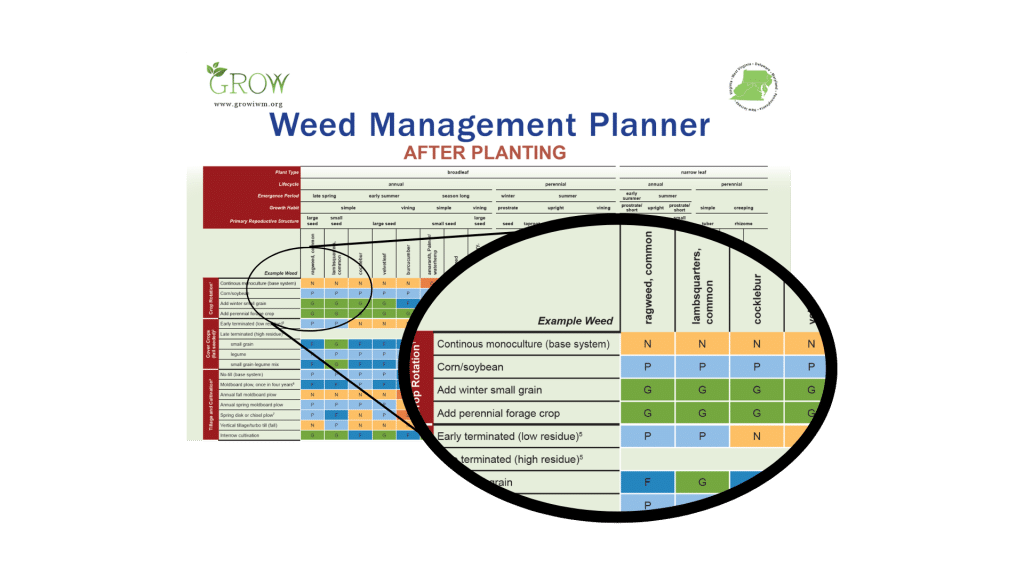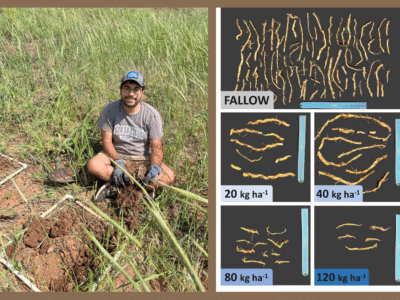Creating a better weed control strategy just got a little easier! GROW’s newest resource, the Weed Management Planner, is designed to help farmers sort through many different weed control tactics, both chemical and non-chemical, quickly and comprehensively.
The Planner consists of two charts – one devoted to pre-planting options, the other to post-planting. Both charts detail the effect common crop and weed management tactics have on each individual weed throughout the growing season.
Rather than sorting through lengthy text and studies, farmers can simply find their problem weed and quickly scan through the efficacy ratings of a long list of management options, including:
- Crop Rotation
- Cover Crop Use
- Tillage and Cultivation
- Planting Date & Methods
- Fertility Practices
- Harvest Weed Seed Control
- Chemical Use
Efficacy ratings range from detrimental (D), to no effect (N), poor (P), fair (F), good (G) and excellent (E).

“Integrated weed management is complicated because every change a farmer makes to their production system has a ripple effect on everything else in the system,” as Virginia Tech Weed Specialist Dr. Michael Flessner explains. “These tables allow farmers to easily glance through many tactics to see options that can be added to their operation, as well as tactics to avoid that might make the weed problem worse.”
The goal is to help farmers manage the growing need to supplement their herbicide use.
“As many Extension specialists have said for years, herbicide resistance is outpacing new herbicide commercialization,” Flessner says. “I hope that farmers can use this as a quick reference to improve use of non-chemical weed control measures to complement herbicides.”

The Weed Management Planner represents two years of work by a group of weed scientists in the Mid-Atlantic from Virginia Tech, Penn State, Rutgers, West Virginia University and the Universities of Delaware and Maryland. The group first conceived of the Planner during an annual meeting to update the Mid-Atlantic Weed Management Guide, which – while full of valuable information – packs 100+ pages of texts, charts and graphics.
UDEL’s Dr. Mark VanGessel pitched the idea of a guide that zoomed in on non-chemical options, and the group quickly agreed that a quick-reference chart would be a welcome resource for the fast-moving farming community.
The Weed Management Planner is currently focused on common weeds in the mid-Atlantic region, but should be a useful reference for growers in other regions with similar weed spectrums and crop production practices, such as the Midwest. Plus, each weed is categorized by its growing characteristics, such as perennial or annual, vining or upright, small seed or large seed – a brainchild of Dr. John Wallace, at Penn State. “Since these key attributes of the weeds really drive the efficacy ratings, this addition allows the table to be used for weeds that are not specifically listed,” Flessner notes.
“We hope that by creating this example for the mid-Atlantic region, other regions can leverage the formatting and approach to create similar versions for their farmers.”
Dr. Michael Flessner, VA Tech
The group also hopes that the format and approach of the Weed Management Planner will ultimately be adopted by scientists in different regions.
“While creating the table, we looked for other examples from other regions and didn’t find any,” Flessner recalls. “A comment was made, during our lengthy debates, that we now know why no one has made this kind of reference before – because it is really hard to do! And like most things in agriculture, it is regionally specific. So, we hope that by creating this example for the mid-Atlantic region, other regions can leverage the formatting and approach to create similar versions for their farmers.”
You can now find the Weed Management Planner in a number of places on the GROW website, including on the Main Page, on the A-B-Cs of Integrated Weed Management and in the Weed Management Toolbox.
Text by Emily Unglesbee, GROW





























































































